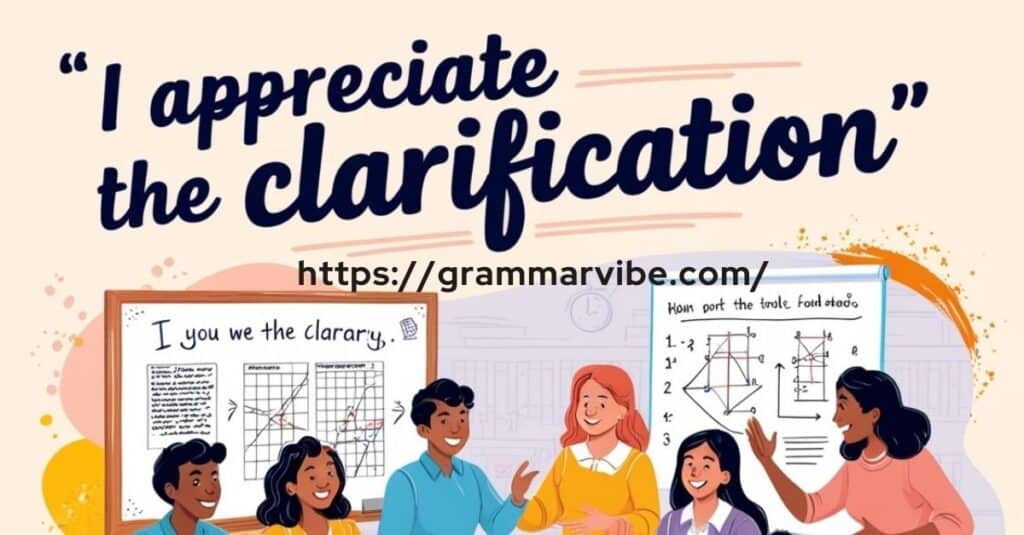In both professional and personal communication, there are times when someone provides insight or clears up a misunderstanding. It’s polite and thoughtful to acknowledge this, especially when it helps in decision-making or gives a clear direction for a project. Instead of repeating “Thank you for the clarification” each time, there are various phrases you can use to express sincere appreciation while sounding conversational, professional, or even casual, depending on the context.
We will discuss alternative ways to say “Thank you for the clarification,” with examples for each in scenarios like follow-up emails, work conversations, and even casual messages.
1. Thanks for clearing that up
In professional and casual exchanges alike, “Thanks for clearing that up” is a friendly, concise way to acknowledge someone’s efforts in providing clarity. This phrase works well when you’re acknowledging a minor misunderstanding or misconception.
Example:
Subject: Project Timeline
“Hi Alex, thanks for clearing that up about the project timeline. It makes it much easier to plan the next steps on my end!”
2. I appreciate the detailed explanation
When someone offers a thorough breakdown, this phrase acknowledges their effort in providing a comprehensive answer. It’s a good fit for more formal, detailed responses in emails or reports.
Example:
Subject: Policy Update Clarification
“Dear Sarah, I appreciate the detailed explanation of the policy changes. It really helps in understanding how it applies to our team’s workflow.”
3. Thank you for the insight
“Thank you for the insight” is a polite and respectful way to show gratitude for unique perspectives or valuable information. It’s suitable for team discussions or client interactions.
Example:
“Hi Dr. Patel, thank you for the insight on recent industry trends. Your perspective gives us a much clearer understanding of potential directions.”
More for you: 15 Other Ways to Say “Well Noted” in an Email
4. Thanks for the additional information
If someone provides extra details that enhance your understanding, use this phrase. It’s excellent for cases when new data or reports come in that provide context or depth.
Example:
Subject: Quarterly Report Details
“Thanks for the additional information on the quarterly report, Jenna. It’s really helpful to see those specific metrics.”
5. I appreciate the clarification

Straightforward and respectful, “I appreciate the clarification” works well in professional settings where a neutral, formal tone is preferred.
Example:
Subject: Workflow Process
“Hi Carl, I appreciate the clarification on the new workflow process. I feel much more confident about moving forward.”
6. Thank you for making that clear
This expression shows sincere appreciation for someone’s effort in simplifying a complex topic. It’s suitable for use in technical discussions, policy clarifications, or email threads.
Example:
“Thank you for making that clear, Teresa. Knowing these steps helps a lot with the troubleshooting process.”
You might also like: 15 Other Ways to Say “I’m Proud of You”
7. Thanks for the explanation
This casual yet respectful phrase is ideal for acknowledging explanations that help resolve misunderstandings or answer basic questions.
Example:
“Thanks for the explanation, Ahmed! Now I understand why we need those additional steps in the process.”
8. I appreciate your help in understanding this
Sometimes, the depth of a topic requires extra guidance. Using this phrase conveys that the information is valuable for your deeper understanding of the matter.
Example:
“Thank you, Emily, for your help in understanding this! Your examples make it much easier to grasp the concept.”
9. Thank you for shedding light on this
This phrase can be used to express gratitude for clarification on topics that are intricate or require expert insights. It’s appropriate for formal settings or complex discussions.
Example:
“Dr. Cho, thank you for shedding light on this. Your expertise has been invaluable in helping us address this issue.”
Check out this: 15 Other Ways to Say “My Name Is”
10. Thanks for elaborating on that
Use this when someone provides extra context or further explanation that enriches your understanding. It’s slightly more formal but still maintains a friendly tone.
Example:
“Thanks for elaborating on that point, Max. I think it’s going to make a big difference in how we approach the task.”
11. Your insights are very helpful
This phrase shows genuine appreciation and acknowledges that the other person’s input has positively impacted your perspective or approach.
Example:
“Your insights are very helpful, Lisa. This will definitely guide us in making the right decisions.”
12. I’m grateful for the additional context
This phrase works well in formal emails when someone provides extra details that clarify background information, policy, or procedure.
Example:
“I’m grateful for the additional context, Dr. Adams. It gives us a more solid foundation for the project.”
13. This really clears things up for me

Acknowledge how someone’s explanation has effectively resolved confusion. This is perfect for informal conversations or follow-up messages.
Example:
“Thanks, Ben. This really clears things up for me—I appreciate you taking the time to explain.”
For your interest: 15 Other Ways to Say “I Hope You Feel Better”
14. I value your perspective on this
Use this phrase to express respect for someone’s unique viewpoint, especially in contexts involving strategic thinking or industry insights.
Example:
“Thanks, Julia. I value your perspective on this, and I’m sure it’ll help us shape a better strategy.”
15. Thank you for addressing my concerns
When someone responds directly to your questions or clears up concerns, this phrase is both polite and professional.
Example:
“Thank you for addressing my concerns, Tom. Your response has given me a much clearer view of the situation.”
Alternative Ways to Say “Thank You for the Clarification”
| Alternative Phrase | Example Context |
|---|---|
| Thanks for clearing that up | Quick email response |
| I appreciate the detailed explanation | Formal email in professional setting |
| Thank you for the insight | Office conversation or team meeting |
| Thanks for the additional information | Project update or technical query |
| I appreciate the clarification | Email thread or meeting follow-up |
| Thank you for making that clear | General acknowledgment in email |
| Thanks for the explanation | Follow-up email or casual chat |
| I appreciate your help in understanding this | Discussion about complex subjects |
| Thank you for shedding light on this | Industry or policy explanation |
| Thanks for elaborating on that | Follow-up to a report or proposal |
| Your insights are very helpful | Appreciation in a client or team email |
| I’m grateful for the additional context | New project background or client brief |
| This really clears things up for me | Direct reply to detailed information |
| I value your perspective on this | Professional tone in strategic context |
| Thank you for addressing my concerns | Follow-up on specific questions |
Conclusion
In professional and personal interactions, expressing gratitude for someone’s clarification is a great way to strengthen communication and demonstrate respect for their effort. Using diverse phrases shows attentiveness and adaptability, which can enhance rapport and keep conversations engaging. Whether you’re addressing a minor misunderstanding or acknowledging a deeper insight, choosing a unique phrase reflects genuine appreciation and attention to detail.
Adopting these alternative expressions also adds a touch of personality to your communication. From “Thanks for clearing that up” to “I value your perspective on this,” each phrase allows you to convey appreciation in a way that feels natural and sincere. By varying your wording, you’ll leave a positive impression and encourage continued open, effective communication. Remember, even small gestures of thanks can make a big difference in building trust and clarity in any relationship.

Kyren Paul is an experienced blogger and the creative mind behind “Grammar Vibe.” With a passion for the nuances of English grammar, he brings clarity and insight to everyday language topics, making grammar accessible and engaging for readers of all levels.











Leave a Comment